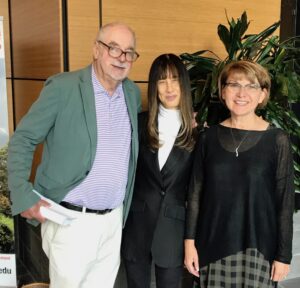On August 25, the Chippewa River Writing Project welcomed Gerald Graff and Cathy Birkenstein — authors of They Say, I Say: The Moves That Matter in Academic Writing — to Central Michigan University. During the morning, they led a roundtable discussion of approximately twenty-five CMU graduate assistants and writing/writing intensive faculty. After lunch, they led a similar roundtable for approximately fifteen teachers 6-12 who represented school districts across the lower peninsula. From 3:30 – 5:00, Graff & Birkenstein gave a public talk in French Auditorium of the EHS Building, followed by an informal reception.
What follows is Liz Brockman’s introduction to Graff and Birkenstein’s public talk:

My name is Elizabeth Brockman, and I’m an English professor here at Central Michigan University and a founding co-director of the Chippewa River Writing Project. On behalf of the writing project, I’d like to begin by thanking our partners in the sponsorship of today’s event: the CMU Writing Center, the College of Humanities and Social & Behavioral Sciences, the College of Education and Human Services, and the Center for Excellence in Teaching and Learning.
Imagine that you enter a parlor. You come late. When you arrive, others have preceded you, and they are engaged in a heated discussion, a discussion too heated for them to pause and tell you exactly what it is about. In fact, the discussion had already begun long before any of them got there so that no one present is qualified to retrace for you all the steps that had gone before. You listen for a while until you decide that you have the tenor of the argument; then you put in your oar. Someone answers; you answer him; another comes to your defense; another aligns himself against you, to either the embarrassment or gratification of your opponent, depending upon the quality of your ally’s assistance. However, the discussion is interminable. The hour grows late, you must depart. And you do depart, with the discussion still vigorously in progress.
You have all undoubtedly read or heard Burke’s Parlor Metaphor on many different occasions, but I can think of no better time to invoke it than at this very moment, as we await a conversation with Gerald Graff and Cathy Birkenstein, the authors of They Say, I Say: The Moves That Matter in Academic Writing. Skeptics (perhaps some even in the room) might claim that They Say, I Say fosters formulaic writing because of the distinctive use of templates found within the book. Proponents of this perspective might compare the templates to five-paragraph essays and other reductive pedagogical strategies. On the other hand, Graff & Birkenstein and their advocates would insist that the templates do not thwart critical or creative thinking. On the contrary, the templates PROMOTE these qualities because they are generative in nature, demonstrating the rhetorical moves all academics use and, in so doing, offering our students the language to expand their thinking in robust and what would otherwise be not conceived of ways. And, of course, the templates collectively illustrate the book’s primary message: that academic writing is most accurately characterized as conversation—the kind of on-going and spirited conversation that our newcomer joins in Burke’s parlor metaphor. In the book, Graff and Birkenstein contend that:
The underlying structure of effective academic writing—and all responsible public discourse—resides not just in stating OUR ideas, but in listening closely to OTHERS around us, summarizing their views in a way that they will recognize, and responding with our own ideas in kind. In other words [aside: that’s metacommentary], to give writing the most important thing of all—namely a point—a writer needs to indicate clearly not only what his or her thesis is, but also what larger conversation that thesis is responding to.
There is good reason, then, why the newcomer in Burke’s parlor metaphor listens closely and attentively to the conversation at hand before “putting in his or her oar.” He or she wants to be heard and to push the conversation forward.

To be sure, They Say, I Say is grounded in social views of writing and writing pedagogy, but a strong social justice imperative also exists within its theoretical underpinnings. To clarify, let’s look more closely at this newcomer in Burke’s parlor metaphor. More than twenty-five years ago, Mary Kupiec Cayton argued that the newcomer must be a person of privilege simply to have gained entrance into the parlor and to be taken seriously by the other attendees. As she persuasively suggests, there are presumably other people associated with, but marginalized from, the parlor—those paid to clean the parlor, for example, or to serve the food—who don’t have the access or power to join the conversation and move it forward. To extend Cayton’s line of thinking in a slightly different direction, however, I wonder now if, there could have been previous newcomers in the parlor on other evenings who listened attentively, caught the tenor of the conversation, but couldn’t figure out how to break into the exchange because they lacked “the moves” to do so.
Enter They Say, I Say—a book with the explicit purpose of demystifying and democratizing academic writing by showing newcomers—all newcomers, especially those outside of the parlor as it’s been traditionally defined—the “moves that matter” in language that is accessible, user-friendly, and immediately applicable. And the book is such a slim volume too, about the same size as an I-Pad Mini or Kindle.
Well, it’s time to get this conversation started.
GERALD GRAFF, an emeritus professor of English and Education at the University of Illinois at Chicago, has had a major impact on American education through the Common Core State Standards, which prominently cite his work on the importance of “argument literacy” for college and career readiness. He is the author of such books as Clueless in Academe: How Schooling Obscures the Life of the Mind, Beyond the Culture Wars: How Teaching The Conflicts Can Revitalize American Education, and Professing Literature: An Institutional History. In 2008 he served as the President of the Modern Language Association of America.
CATHY BIRKENSTEIN-GRAFF is the co-author with Gerald Graff of the best-selling textbook, They Say/I Say: The Moves That Matter in Academic Writing, which also has a version with readings co-written with Graff and Russel Durst, and a version for high schools. A lecturer at the University of Illinois at Chicago, Dr. Birkenstein has published essays on writing in College English and, with Graff, in The Chronicle of Higher Education, Academe, and College, Composition, and Communication.
Please join me in welcoming Gerald Graff and Cathy Birkenstein …
Works Cited
Burke, Kenneth. The Philosophy of Literary Form. Berkeley: University of California Press, 1941.
Cayton, Mary Kupiec. “Writing as Outsiders: Academic Discourse and Marginalized Faculty.” College English 53.6 (1991): 647-660.
Gerald Graff and Cathy Birkenstein. They Say, I Say: The Moves That Matter in Academic Writing, 3rd edition. New York: Norton, 2014.
 Elizabeth Brockman is a founding co-director of the Chippewa River Writing Project. A former middle and high school English teacher, Elizabeth is currently a professor in the English Department at CMU, where she teaches composition and composition methods courses.
Elizabeth Brockman is a founding co-director of the Chippewa River Writing Project. A former middle and high school English teacher, Elizabeth is currently a professor in the English Department at CMU, where she teaches composition and composition methods courses.

This work is licensed under a Creative Commons Attribution-NonCommercial-ShareAlike 4.0 International License.

Leave a Reply
You must be logged in to post a comment.